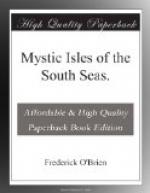The sorcerers, ecstatics, and demoniacs were not regularly organized into a caste. When a man fancied himself possessed by a god, he became a recognized saint. He was tabu. He ascended to the altar and danced or gyrated as he pleased. The old missionaries, who believed these sorcerers inhabited by devils, record incredible deeds by them. Often the spirit forsook them, and they became common clay, but when primed with the deity’s power, they would ascend vertical rocks of great height by touching the smooth surface with tiny idols which they held in their hands, and without any contact by their feet. These demoniacs recall the oracles of ancient nations, and especially Simon Magus, the precursor of innumerable fathers of new religions, who by the power of the “Christian God” fell to a horrible death when he tried to fly before the Roman emperor on the wings of the devil.
Before a day of sacrifice a victim was selected by the high priest. The victim had no knowledge of his approaching end. He must not be informed, and though his father and mother and family were told in advance, they never warned their unfortunate loved one. No hand was lifted to avert his fate, for he was tabu to the gods. Though no excuse could be offered for the slaying of their own clansman except the direful hold of religion, which in Tahiti, as in Europe not so long ago, put Protestant and Catholic on the pyre in the name of Christ, yet so soft-hearted were these people that they could not disturb the peace of mind of the offering, and until the moment when he was struck down from behind he was as unconcerned as any one. They never tortured as the English and French tortured Joan of Arc, and as the police of America torture thousands of Americans every day.
I looked long at this ruined pagan tabernacle, this arc of the covenant for Oberea and Oamo, and for Tetuanui’s fathers. The chief said that his grandfather had seen it in its palmy period. Oberea was an ancestress of my host of Papara, Tati Salmon, who had the table-ware of Stevenson, and who was of the clan of Teva, as she.
Wrecked, battered by the surf, torn to pieces by pickaxes, undermined by the sea, and overgrown by the rank foliage of the tropics, the marae preserved for me and for Brooke, too, a solemnity and reminiscent grandeur that brought a vision of the beauty and might of the passionate Oberea, who had commanded it to be built. Though different in environment as the sea from the desert, and in size and aspect, materials and history, I was transported from this Tahitian temple to the pyramids on the sands of Egypt. Forty centuries later I could trace the same aspiration for community with deity and for immortality of monument which had sweated a hundred thousand men for twenty years to rear the lofty pile of Gizeh. In Borobodo, in the jungle of Java, I had seen, as near Cairo, the proudest trophy, temple, and tomb of king and priest humbled in the dust by the changing soul of man in his fight to throw off the shackles of the past.




